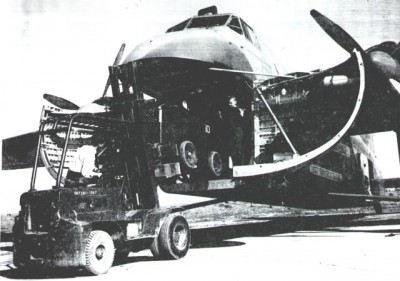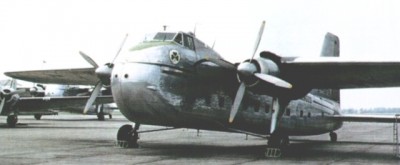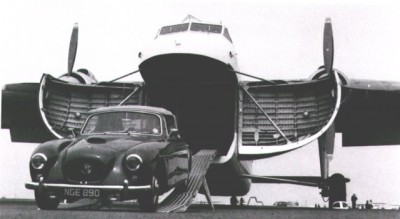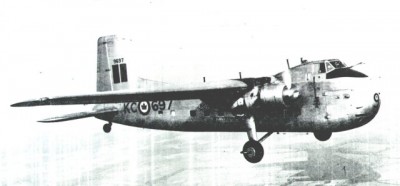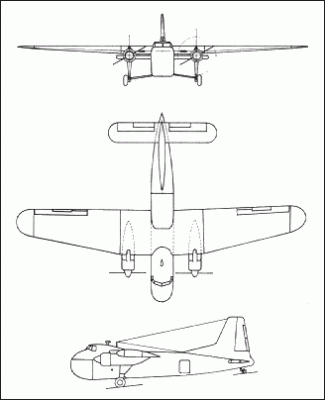Bristol Type 170 Freighter
History:
In 1944, the British Air Ministry ( Air Ministry ) issued specification 22/44, which called for a transport aircraft for short-haul flights. This specification was subsequently changed to the new G.9/44 specification, which called for :
(1) a payload capacity of about 3 000 kg
2. the ability to operate from small unprepared take-off and landing areas
3) the ability to carry passengers
4) the ability to carry bulky cargo
Many competitors did not respond to this specification and so only Bristol Aircraft Factory came forward with their Bristol Type 170 project. The chief designer, A.E. Russell, designed a simple twin-engine monoplane with the wing placed in the upper half of the fuselage. The main landing gear was fixed as was the tail wheel. The cargo was loaded into the aircraft through the front fuselage section, which was hinged to the side. Thanks to this system, the aircraft could also carry larger loads. The first prototype first flew from the factory airfield at Filton on 2 December 1945, piloted by test pilot C.F. Uwins, the prototype was marked with the civilian mark G-AGPV. To satisfy the specification, Bristol built a second prototype, this was primarily designed to carry 32 passengers. The second prototype bore the civilian designation G-AGVB, and first flew on 30 April 1946. A third prototype, designated G-AGVC, was then built. This third prototype had, in comparison to the first prototype produced, a fully functional mechanism for tipping the front part of the fuselage. After the successful flight of the prototypes, serial production began in 1946. The aircraft was used in the military air forces of many countries, but also in civil aviation. The civilian version of the aircraft was designated the Bristol Type 170 Wayfarer. The aircraft was produced in many military as well as civilian versions. Eventually 214 machines of all versions were produced, and in 1958 serial production ended.
The Bristol Type 170 was a twin-engined monoplane aircraft, designed for both transport and passenger purposes. The main undercarriage was a two-wheel fixed undercarriage, the main landing gear legs were attached directly to the engine nacelle from below, the landing gear leg was additionally attached by a strut to the fuselage. The tail wheel was also fixed. The aircraft was powered by a pair of air-cooled Bristol Hercules 734 twin-turbo 14-cylinder engines, each producing 1,980 hp. The aircraft had a top speed of 362 km/h (362 mph), with a cruise speed of 262 km/h (262 mph). The payload of the aircraft varied according to the versions produced, but ranged up to a maximum of 8,200 kg. The interior of the fuselage could be combined in various ways, depending on the versions, the aircraft could carry either cargo, 32 fully armed soldiers, 23 paratroopers, or a civilian version of 32 passengers.
An overview of the Bristol Type 170 versions produced:
Source:
www.glostransporthistory.visit-gloucestershire.co.uk
www.en.wikipedia.org
www.en.wikipedia.org
http://www.kiwiaircraftimages.com/b170.html
http://www.airwar.ru/enc/craft/freighter.html
www.aviastar.org
http://www.en.wikipedia.org/wiki/Bristol_Freighter
http://www.en.wikipedia.org/wiki/Bristol_Hercules
www.airliners.net
History:
In 1944, the British Air Ministry ( Air Ministry ) issued specification 22/44, which called for a transport aircraft for short-haul flights. This specification was subsequently changed to the new G.9/44 specification, which called for :
(1) a payload capacity of about 3 000 kg
2. the ability to operate from small unprepared take-off and landing areas
3) the ability to carry passengers
4) the ability to carry bulky cargo
Many competitors did not respond to this specification and so only Bristol Aircraft Factory came forward with their Bristol Type 170 project. The chief designer, A.E. Russell, designed a simple twin-engine monoplane with the wing placed in the upper half of the fuselage. The main landing gear was fixed as was the tail wheel. The cargo was loaded into the aircraft through the front fuselage section, which was hinged to the side. Thanks to this system, the aircraft could also carry larger loads. The first prototype first flew from the factory airfield at Filton on 2 December 1945, piloted by test pilot C.F. Uwins, the prototype was marked with the civilian mark G-AGPV. To satisfy the specification, Bristol built a second prototype, this was primarily designed to carry 32 passengers. The second prototype bore the civilian designation G-AGVB, and first flew on 30 April 1946. A third prototype, designated G-AGVC, was then built. This third prototype had, in comparison to the first prototype produced, a fully functional mechanism for tipping the front part of the fuselage. After the successful flight of the prototypes, serial production began in 1946. The aircraft was used in the military air forces of many countries, but also in civil aviation. The civilian version of the aircraft was designated the Bristol Type 170 Wayfarer. The aircraft was produced in many military as well as civilian versions. Eventually 214 machines of all versions were produced, and in 1958 serial production ended.
The Bristol Type 170 was a twin-engined monoplane aircraft, designed for both transport and passenger purposes. The main undercarriage was a two-wheel fixed undercarriage, the main landing gear legs were attached directly to the engine nacelle from below, the landing gear leg was additionally attached by a strut to the fuselage. The tail wheel was also fixed. The aircraft was powered by a pair of air-cooled Bristol Hercules 734 twin-turbo 14-cylinder engines, each producing 1,980 hp. The aircraft had a top speed of 362 km/h (362 mph), with a cruise speed of 262 km/h (262 mph). The payload of the aircraft varied according to the versions produced, but ranged up to a maximum of 8,200 kg. The interior of the fuselage could be combined in various ways, depending on the versions, the aircraft could carry either cargo, 32 fully armed soldiers, 23 paratroopers, or a civilian version of 32 passengers.
An overview of the Bristol Type 170 versions produced:
| Freighter Mk.I | first series of military transport aircraft ( reinforced floor ) | ||
|---|---|---|---|
| Freighter Mk.IA | version with 16 passenger seats | ||
| Freighter Mk.IB, Mk.IC | modified version of Mk.I with 16 seats, intended for civil airlines | ||
| Wayfarer Mk.II, Mk.IIA, Mk.IIB | civil version designed to carry 32 passengers | ||
| Wayfarer Mk.IIC | modified civilian version of the Mk.II, added luggage compartment, but only 20 passenger seats | ||
| Freighter Mk.XI | version with increased wingspan ( to 32.92 m ) | ||
| Freighter Mk.21 | version powered by twin more powerful engines, Bristol Hercules, with a single engine output of 3,380 hp. Freighter Mk.21E | Freighter Mk.21E | a modified version of the Mk.21, fitted with 32 seats that could be easily dismountable |
| Freighter Mk.31 | modified version of the Mk.21 extended SOP | ||
| Freighter Mk.31E | modified version of Mk.31 | ||
| Freighter Mk.31M | military version modified for dropping supplies from the air | ||
| Freighter Mk.32 | version with increased cargo hold clearance |
Source:
www.glostransporthistory.visit-gloucestershire.co.uk
www.en.wikipedia.org
www.en.wikipedia.org
http://www.kiwiaircraftimages.com/b170.html
http://www.airwar.ru/enc/craft/freighter.html
www.aviastar.org
http://www.en.wikipedia.org/wiki/Bristol_Freighter
http://www.en.wikipedia.org/wiki/Bristol_Hercules
www.airliners.net
